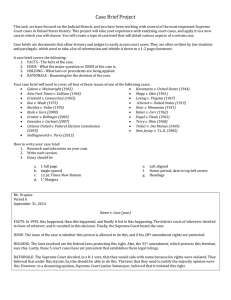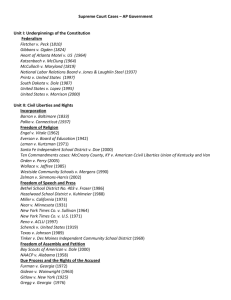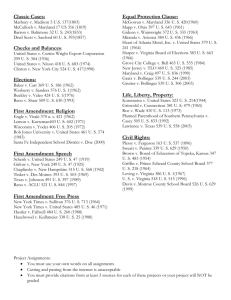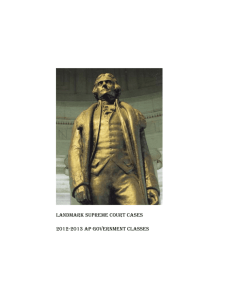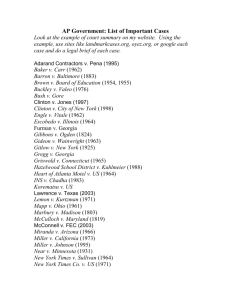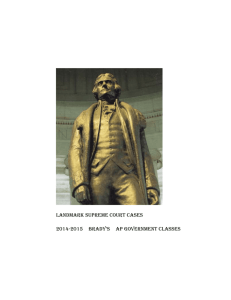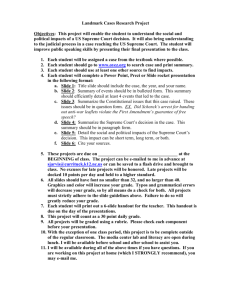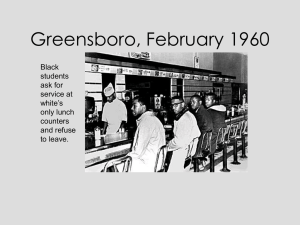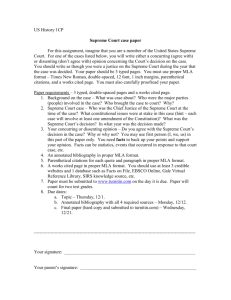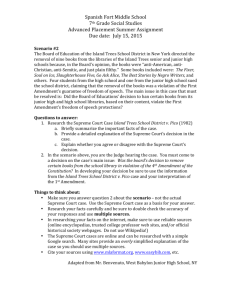DOC - McCormick Foundation
advertisement
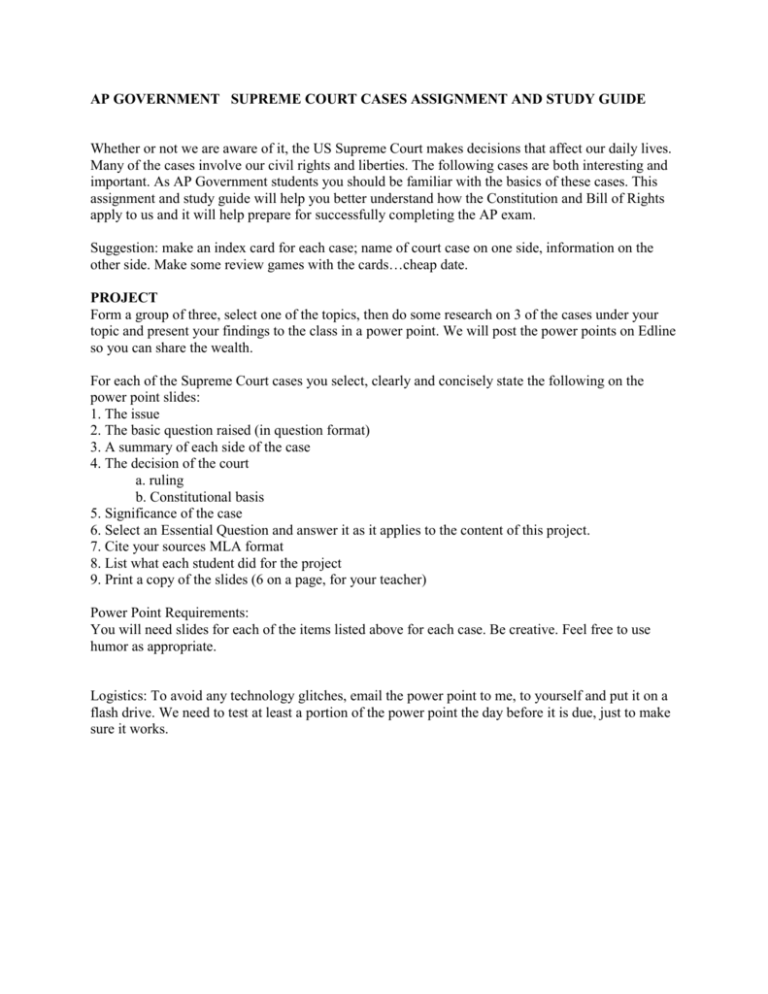
AP GOVERNMENT SUPREME COURT CASES ASSIGNMENT AND STUDY GUIDE Whether or not we are aware of it, the US Supreme Court makes decisions that affect our daily lives. Many of the cases involve our civil rights and liberties. The following cases are both interesting and important. As AP Government students you should be familiar with the basics of these cases. This assignment and study guide will help you better understand how the Constitution and Bill of Rights apply to us and it will help prepare for successfully completing the AP exam. Suggestion: make an index card for each case; name of court case on one side, information on the other side. Make some review games with the cards…cheap date. PROJECT Form a group of three, select one of the topics, then do some research on 3 of the cases under your topic and present your findings to the class in a power point. We will post the power points on Edline so you can share the wealth. For each of the Supreme Court cases you select, clearly and concisely state the following on the power point slides: 1. The issue 2. The basic question raised (in question format) 3. A summary of each side of the case 4. The decision of the court a. ruling b. Constitutional basis 5. Significance of the case 6. Select an Essential Question and answer it as it applies to the content of this project. 7. Cite your sources MLA format 8. List what each student did for the project 9. Print a copy of the slides (6 on a page, for your teacher) Power Point Requirements: You will need slides for each of the items listed above for each case. Be creative. Feel free to use humor as appropriate. Logistics: To avoid any technology glitches, email the power point to me, to yourself and put it on a flash drive. We need to test at least a portion of the power point the day before it is due, just to make sure it works. COVER SHEET AND RUBRICS FOR SUPREME COURT ASSIGNMENT Attach this cover sheet to your printout of the power point slides. Names of students in group (* next to leader): 1. 2. 3. Topic addressed in presentation: List of court cases selected for your presentation: 1. 2. 3. Content: (30 pts.) For each of the following Supreme Court cases you select, clearly and concisely state the following: 1. The issue 2. The basic question raised (in question format) 3. A summary of each side of the case 4. The decision of the court a. ruling b. Constitutional basis 5. Significance of the case 6. Select an Essential Question and answer it as it applies to the content of this project. 7. Cite your sources 8. List what each student did for the project 9. Print a copy of the slides (6 on a page, for your teacher) Presentation (5 pts.) 1. Is the presentation well organized and easy to follow? 2. Slide design: Are the slides well designed and easy to read? 3. Did you follow all directions on the rubric? 4. Did your group work as a team? 5. Did your class learn from your presentation? List of Supreme Court Cases by Topic (see your binder of readings for basic descriptions of the cases) I. 1st Amendment Religion/Establishment 1a. Engel v. Vitale (1962) 1b. Abington School District v. Schempp (1963) 1c. Lemon v. Kurtzman (1971) Religion/Free Exercise 2a. Wisconsin v. Yoder (1972) 2 b. Oregon v. Smith (1990) 2 c. Bd. Of Education of Westside Community Schools v Mergens (1990) 2 d. Minersville School District v. Gobitis (also establishment) 1940 Expression/Speech 3 a. Schenck v. U.S. (1919) 3 b. Gitlow v. New York (1925) 3 c. Tinker v. Des Moines (1969) 3 d. Miller v. California (1973) 3 e. Texas v. Johnson (1989) 3 f. Buckley v. Valeo (1976) 3 g. Frederick v. Morse (2007) Expression/Press 4 a. Near v. Minnesota (1931) 4 b. NY Times v. Sullivan (1964) 4 c. New York Times v. U.S. (1971) 4 d. Hazelwood v. Kuhlmeier (1988) Expression/Assembly 5 a. Village of Skokie v. National Socialist Party (1978) 5 b Newdow v. U.S. Congress (2002) 5 c. Hurley v. Irish American GLIB Association (1995) 5 d. Snyder v. Phelps (2011) II. Criminal Procedures 6 a. Powell v. Alabama (1932) 6 b. Betts v. Brady (1942) 6 c. Gideon v. Wainwright (1963) 6 d. Escobido v. Illinois (1964) 6 e. Miranda v. Arizona (1966) 6 f. Mapp v. Ohio (1961) 6 g. New Jersey v. T.L.O. (1985) III. Personal Liberty 7 a. Griswold v. Connecticut (1965) 7 b. Roe v. Wade (1973) 7 c. Korematsu v. U.S. (1944) IV. Civil Rights/Due Process/Equal Protection 8 a. Regents of the U. of California v. Bakkee (1978) 8 b. Gratz v. Bollinger/Grutter v. Bollinger (2003) 8 c. Goss v. Lopez (1975) V. Federalism 9 a. U.S. v. Lopez (1995) 9 b. South Dakota v. Dole (1987) 9 c. Baker v. Carr (1962) VI. Supremacy 10 a. Gibbons v. Ogden (1824) VII. Executive Privilege 11 a. U.S. v. Nixon (1974) 11 b. Clinton v. Jones VIII. Elections 12 a. Bush v. Gore (2000) IX. Classic Cases 13 a. Marbury v. Madison (1803) 13 b. McCulloch v. Maryland (1819) 13 c. Dred Scott v. Sandford (1857) 13 d. Plessey v. Ferguson (1896) 13 e. Brown V. Bd. of Education (1954) X. Representation in Legislative Districts (One person , one vote) 14. a. Baker v. Carr (1962) 14 b. Reynolds v. Sims (1964) 14 c. Wesberry v. Sanders (1964) XI. Recent Cases 15 a D.C. v. Heller (2nd amendment) (2008) 15 b McDonald v. Chicago (2nd Amendment) (2010) 16. Hamdi v. Rumsfield (rights of terror suspects) 17. Hamdan v. Rumsfeld (terror suspects) 18. Boumediene v. Bush (terror suspects)
